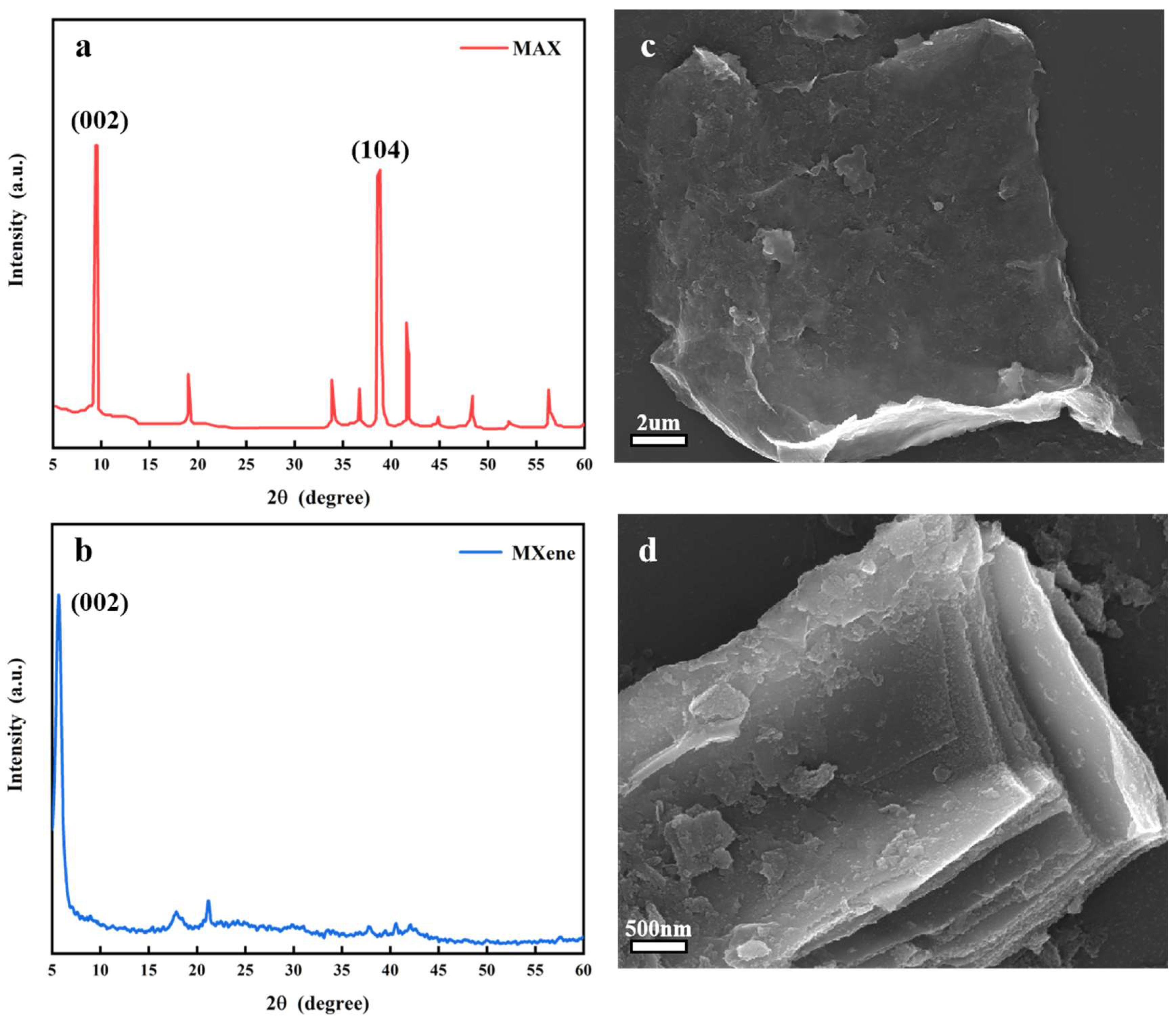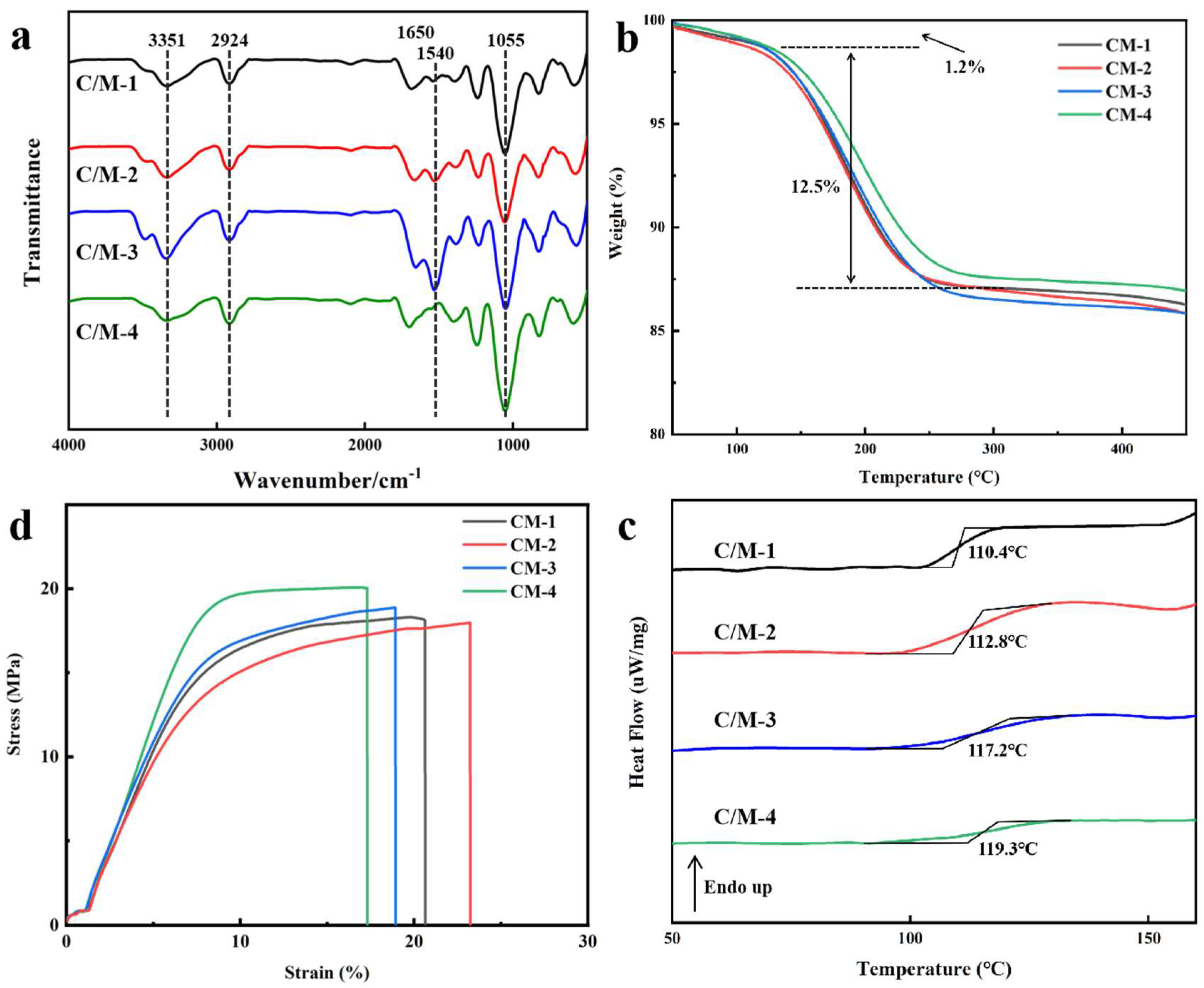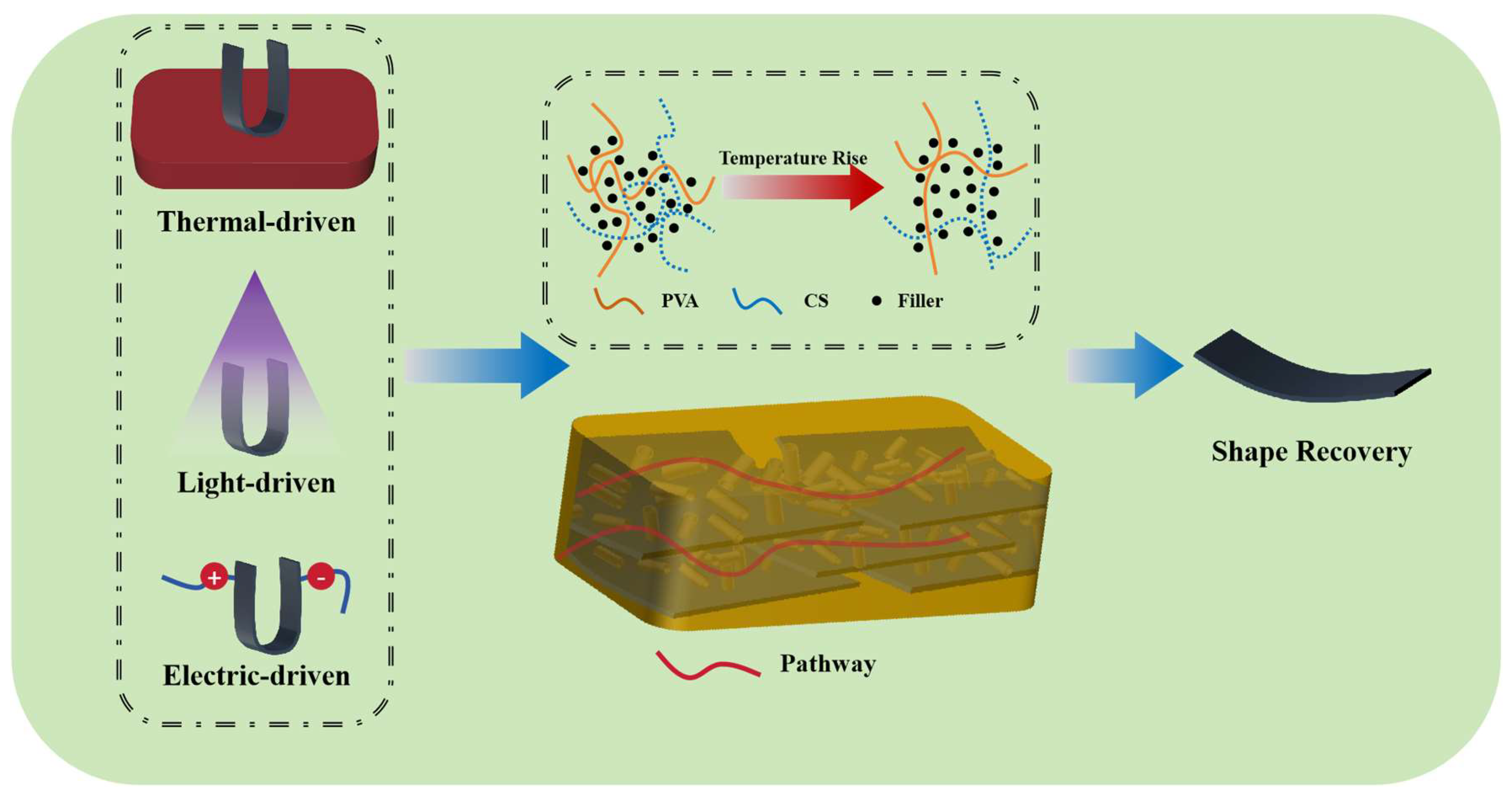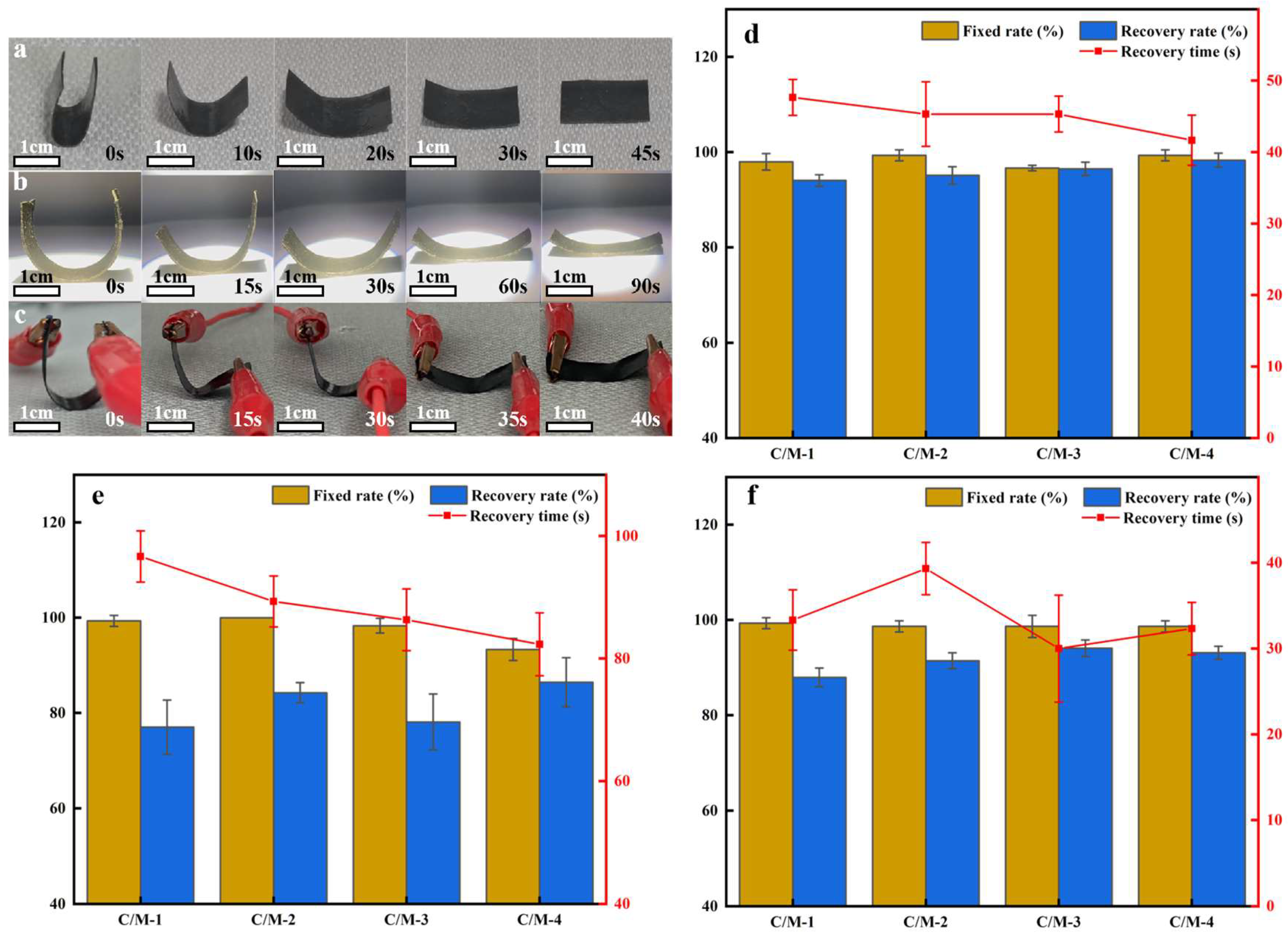Synergistic Effects of MXene and Carbon Nanotubes in Multi-Stimuli-Responsive Chitosan Materials: Combining Shape Memory and Electromagnetic Shielding Functions
Abstract
1. Introduction
2. Materials and Methods
2.1. Materials
2.2. Preparation of MXene and Functional Composites
2.3. Characterization
3. Results and Discussion
3.1. MXene Structure and Morphology
3.2. FTIR, TGA and DSC
3.3. Mechanical Properties
3.4. Multi-Stimuli-Responsive Shape Memory Behaviors
3.5. EMI Shielding Performance
4. Conclusions
Author Contributions
Funding
Institutional Review Board Statement
Informed Consent Statement
Data Availability Statement
Conflicts of Interest
References
- Yang, S.; Song, Z.; He, Z.; Ye, X.; Li, J.; Wang, W.; Zhang, D.; Li, Y. A review of chitosan-based shape memory materials: Stimuli-responsiveness, multifunctionalities and applications. Carbohydr. Polym. 2024, 323, 121411. [Google Scholar] [CrossRef]
- Dayyoub, T.; Maksimkin, A.V.; Filippova, O.V.; Tcherdyntsev, V.V.; Telyshev, D.V. Shape Memory Polymers as Smart Materials: A Review. Polymers 2022, 26, 3511. [Google Scholar] [CrossRef]
- Delaey, J.; Dubruel, P.; Van Vlierberghe, S. Shape Memory Polymers for Biomedical Applications. Adv. Funct. Mater. 2020, 30, 1909047. [Google Scholar] [CrossRef]
- Xia, Y.; He, Y.; Zhang, F.; Liu, Y.; Leng, J. A Review of Shape Memory Polymers and Composites: Mechanisms, Materials, and Applications. Adv. Mater. 2021, 33, 2000713. [Google Scholar] [CrossRef] [PubMed]
- Yang, L.; Lou, J.; Yuan, J.; Deng, J. A review of shape memory polymers based on the intrinsic structures of their responsive switches. RSC Adv. 2021, 11, 28838–28850. [Google Scholar] [CrossRef]
- Zhao, W.; Li, N.; Liu, L.; Leng, J.; Liu, Y. Mechanical behaviors and applications of shape memory polymer and its composites. Appl. Phys. Rev. 2023, 10, 011306. [Google Scholar] [CrossRef]
- Liu, W.; Kong, D.; Zhao, W.; Leng, J. Multi-stimulus responsive shape memory polyurea incorporating stress-mismatching structure for soft actuators and reversible deployable structures. Compos. Struct. 2024, 334, 117966. [Google Scholar] [CrossRef]
- Zhang, Q.; Zhao, Z.; Wu, D.; Chen, K.; Weng, S. Mechanics-guided design of inflatable heterogeneous shape memory polymer vascular stents. Int. J. Mech. Sci. 2023, 254, 108405. [Google Scholar] [CrossRef]
- Hicks, A.J.; Roberts, C.; Robinson, A.; Wilson, K.; Kotamreddy, V.; LaRue, T.; Veyssi, A.; Beltran, F.; Hakim, J.; Rausch, M.K.; et al. Polycaprolactone-based shape memory foams as self-fitting vaginal stents. Acta Biomater. 2024, 187, 172–182. [Google Scholar] [CrossRef]
- Linghu, C.; Zhang, S.; Wang, C.; Yu, K.; Li, C.; Zeng, Y.; Zhu, H.; Jin, X.; You, Z.; Song, J. Universal SMP gripper with massive and selective capabilities for multiscaled, arbitrarily shaped objects. Sci. Adv. 2020, 6, eaay5120. [Google Scholar] [CrossRef]
- Wu, S.; Liu, Y.; Zhang, Y.; Zeng, L.; Fang, J.; Chen, C.; Zhang, C.; Wu, D.; Lao, Z.; Xia, H. High-Load Shape Memory Microgripper with Embedded Resistive Heating and Magnetic Actuation. Adv. Funct. Mater. 2025, 35, 2421798. [Google Scholar] [CrossRef]
- Iqbal, Y.; Ahmed, I.; Irfan, M.F.; Chatha, S.A.S.; Zubair, M.; Ullah, A. Recent advances in chitosan-based materials; The synthesis, modifications and biomedical applications. Carbohydr. Polym. 2023, 321, 121318. [Google Scholar] [CrossRef]
- Negm, N.A.; Hefni, H.H.; Abd-Elaal, A.A.; Badr, E.A.; Kana, M.T.A. Advancement on modification of chitosan biopolymer and its potential applications. Int. J. Biol. Macromol. 2020, 152, 681–702. [Google Scholar] [CrossRef]
- Peterson, G.I.; Dobrynin, A.V.; Becker, M.L. Biodegradable shape memory polymers in medicine. Adv. Healthc. Mater. 2017, 6, 1700694. [Google Scholar] [CrossRef]
- Jin, S.; Guo, Y.; Wang, F.; Zhou, A. The synthesis of MXenes. MRS Bull. 2023, 48, 245–252. [Google Scholar] [CrossRef]
- Gao, S.; Ding, J.; Wang, W.; Lu, J. MXene based flexible composite phase change material with shape memory, self-healing and flame retardant for thermal management. Compos. Sci. Technol. 2023, 234, 109945. [Google Scholar] [CrossRef]
- Zhou, C.; Zhao, X.; Xiong, Y.; Tang, Y.; Ma, X.; Tao, Q.; Sun, C.; Xu, W. A review of etching methods of MXene and applications of MXene conductive hydrogels. Eur. Polym. J. 2022, 167, 111063. [Google Scholar] [CrossRef]
- Iqbal, M.Z.; Khan, M.W.; Siddique, S.; Aftab, S. MXenes: An exotic material for hybrid supercapacitors and rechargeable batteries. J. Energy Storage 2022, 56, 105914. [Google Scholar] [CrossRef]
- Liu, Y.; Liu, Y.; Zhao, X. MXene Composite Electromagnetic Shielding Materials: The Latest Research Status. ACS Appl. Mater. Interfaces 2024, 16, 41596–41615. [Google Scholar] [CrossRef] [PubMed]
- Zeng, Z.; Li, J.; Fang, L.; Zheng, C.; Chen, H.; Huang, J.; Qian, K.; Li, H.; Li, W. Flexible and durable shape memory EVA/MXene/EVA fiber membrane for programmable EMI shielding. Chem. Eng. J. 2024, 501, 157599. [Google Scholar] [CrossRef]
- Li, Z.; Wu, Y. 2D Early Transition Metal Carbides (MXenes) for Catalysis. Small 2019, 15, e1804736. [Google Scholar] [CrossRef]
- Xu, T.; Wang, Y.; Liu, K.; Zhao, Q.; Liang, Q.; Zhang, M.; Si, C. Ultralight MXene/carbon nanotube composite aerogel for high-performance flexible supercapacitor. Adv. Compos. Hybrid Mater. 2023, 6, 108. [Google Scholar] [CrossRef]
- Cui, Y.; Yang, K.; Zhang, F.; Lyu, Y.; Zhang, Q.; Zhang, B. Ultra-light MXene/CNTs/PI aerogel with neat arrangement for electromagnetic wave absorption and photothermal conversion. Compos. Part A Appl. Sci. Manuf. 2022, 158, 106986. [Google Scholar] [CrossRef]
- Xu, W.; Xu, Z.; Liang, Y.; Liu, L.; Weng, W. Enhanced tensile and electrochemical performance of MXene/CNT hierarchical film. Nanotechnology 2021, 32, 355706. [Google Scholar] [CrossRef] [PubMed]
- Sanaka, R.; Sahu, S.K.; Sreekanth, P.S.R.; Giri, J.; Mohammad, F.; Al-Lohedan, H.A.; Saharudin, M.S.; Ma, Q. Heat-responsive PLA/PU/MXene shape memory polymer blend nanocomposite: Mechanical, thermal, and shape memory properties. Polymers 2025, 17, 338. [Google Scholar] [CrossRef]
- Yang, W.; Zhou, W.; Ding, N.; Shen, S.; Gao, D.; Puglia, D.; Duan, Y.; Xu, P.; Liu, T.; Wang, Z.; et al. Biobased photothermal responsive shape memory polythioether/MXene nanocomposites with self-extinguishing performance. Chem. Eng. J. 2024, 497, 154591. [Google Scholar] [CrossRef]
- Zhu, M.; Yan, X.; Xu, H.; Xu, Y.; Kong, L. Highly conductive and flexible bilayered MXene/cellulose paper sheet for efficient electromagnetic interference shielding applications. Ceram. Int. 2021, 47, 17234–17244. [Google Scholar] [CrossRef]
- Zhang, L.; Huang, Y.; Dong, H.; Xu, R.; Jiang, S. Flame-retardant shape memory polyurethane/MXene paper and the application for early fire alarm sensor. Compos. Part B Eng. 2021, 223, 109149. [Google Scholar] [CrossRef]
- Guo, X.-R.; Sheng, P.-H.; Hu, J.-W.; Liu, J.; Wang, S.-L.; Ma, Q.; Yu, Z.-Z.; Ding, Y. Multistimuli-Responsive Shape-Memory Composites with a Water-Assisted Self-Healing Function Based on Sodium Carboxymethyl Cellulose/Poly(vinyl alcohol)/MXene. ACS Appl. Mater. Interfaces 2024, 16, 17981–17991. [Google Scholar] [CrossRef]
- Mohajer, F.; Ziarani, G.M.; Badiei, A.; Iravani, S.; Varma, R.S. MXene-Carbon Nanotube Composites: Properties and Applications. Nanomaterials 2023, 13, 345. [Google Scholar] [CrossRef]
- Thalji, M.R.; Mahmoudi, F.; Bachas, L.G.; Park, C. MXene-Based Electrocatalysts for Water Splitting: Material Design, Surface Modulation, and Catalytic Performance. Int. J. Mol. Sci. 2025, 26, 8019. [Google Scholar] [CrossRef]






| C/M-1 | C/M-2 | C/M-3 | C/M-4 |
|---|---|---|---|
| 110.4 °C | 112.8 °C | 117.2 °C | 119.3 °C |
| Sample | Young’s Modulus (MPa) | Tensile Strength (MPa) | Elongation at Break (%) |
|---|---|---|---|
| C/M-1 | 244.1 ± 3.4 | 18.8 ± 1.6 | 20.6 ± 2.5 |
| C/M-2 | 200.2 ± 15.7 | 17.9 ± 0.2 | 23.2 ± 2.1 |
| C/M-3 | 251.1 ± 17.9 | 18.3 ± 0.6 | 18.9 ± 0.9 |
| C/M-4 | 292.2 ± 23.7 | 20.0 ± 1.1 | 17.3 ± 0.8 |
| Sample | Preset Angle/(°) | θf/(°) | Rf/(%) | θr/(°) | Rr/(%) | Recovery Time/s |
|---|---|---|---|---|---|---|
| C/M-1 | 180 | 176.4 ± 3.1 | 98.0 ± 1.7 | 169.2 ± 2.2 | 94.0 ± 1.2 | 47.7 ± 2.5 |
| C/M-2 | 180 | 178.7 ± 2.2 | 99.3 ± 1.2 | 171.2 ± 3.2 | 95.1 ± 1.8 | 45.3 ± 4.5 |
| C/M-3 | 180 | 174.1 ± 1.1 | 96.7 ± 0.6 | 173.7 ± 2.5 | 96.5 ± 1.4 | 45.3 ± 2.5 |
| C/M-4 | 180 | 178.7 ± 2.2 | 99.3 ± 1.2 | 176.9 ± 2.7 | 98.3 ± 1.5 | 41.7 ± 3.5 |
| Sample | Preset Angle/(°) | θf/(°) | Rf/(%) | θr/(°) | Rr/(%) | Recovery Time/s |
|---|---|---|---|---|---|---|
| C/M-1 | 180 | 178.7 ± 3.1 | 99.3 ± 1.2 | 138.6 ± 12.1 | 77.0 ± 6.7 | 96.7 ± 4.2 |
| C/M-2 | 180 | 180 ± 0 | 100 ± 0 | 151.56 ± 3.8 | 84.2 ± 2.1 | 89.3 ± 4.2 |
| C/M-3 | 180 | 176.9 ± 2.7 | 98.3 ± 1.5 | 140.6 ± 10.4 | 78.1 ± 5.8 | 86.3 ± 5.0 |
| C/M-4 | 180 | 167.9 ± 4.1 | 93.3 ± 2.3 | 155.7 ± 9.2 | 86.5 ± 5.1 | 82.3 ± 5.1 |
| Sample | Preset Angle/(°) | θf/(°) | Rf/(%) | θr/(°) | Rr/(%) | Recovery Time/s |
|---|---|---|---|---|---|---|
| C/M-1 | 180 | 176.4 ± 3.1 | 98.3 ± 1.2 | 158.4 ± 3.6 | 88.0 ± 2.0 | 33.3 ± 3.5 |
| C/M-2 | 180 | 177.5 ± 3.1 | 98.6 ± 1.2 | 164.7 ± 3.1 | 91.5 ± 1.7 | 39.3 ± 3.0 |
| C/M-3 | 180 | 177.5 ± 4.1 | 98.6 ± 2.3 | 169.4 ± 3.1 | 94.1 ± 1.7 | 30 ± 6.2 |
| C/M-4 | 180 | 177.5 ± 3.1 | 98.6 ± 1.2 | 167.6 ± 2.5 | 93.1 ± 1.4 | 32.3 ± 3.0 |
Disclaimer/Publisher’s Note: The statements, opinions and data contained in all publications are solely those of the individual author(s) and contributor(s) and not of MDPI and/or the editor(s). MDPI and/or the editor(s) disclaim responsibility for any injury to people or property resulting from any ideas, methods, instructions or products referred to in the content. |
© 2025 by the authors. Licensee MDPI, Basel, Switzerland. This article is an open access article distributed under the terms and conditions of the Creative Commons Attribution (CC BY) license (https://creativecommons.org/licenses/by/4.0/).
Share and Cite
Li, Z.; Yang, S.; Wang, S.; Liu, J.; Guo, N.; He, Z.; Song, Z.; Li, Y. Synergistic Effects of MXene and Carbon Nanotubes in Multi-Stimuli-Responsive Chitosan Materials: Combining Shape Memory and Electromagnetic Shielding Functions. Coatings 2025, 15, 1332. https://doi.org/10.3390/coatings15111332
Li Z, Yang S, Wang S, Liu J, Guo N, He Z, Song Z, Li Y. Synergistic Effects of MXene and Carbon Nanotubes in Multi-Stimuli-Responsive Chitosan Materials: Combining Shape Memory and Electromagnetic Shielding Functions. Coatings. 2025; 15(11):1332. https://doi.org/10.3390/coatings15111332
Chicago/Turabian StyleLi, Ziyun, Shuai Yang, Sitong Wang, Jiaying Liu, Ning Guo, Zhichao He, Zijian Song, and Yingchun Li. 2025. "Synergistic Effects of MXene and Carbon Nanotubes in Multi-Stimuli-Responsive Chitosan Materials: Combining Shape Memory and Electromagnetic Shielding Functions" Coatings 15, no. 11: 1332. https://doi.org/10.3390/coatings15111332
APA StyleLi, Z., Yang, S., Wang, S., Liu, J., Guo, N., He, Z., Song, Z., & Li, Y. (2025). Synergistic Effects of MXene and Carbon Nanotubes in Multi-Stimuli-Responsive Chitosan Materials: Combining Shape Memory and Electromagnetic Shielding Functions. Coatings, 15(11), 1332. https://doi.org/10.3390/coatings15111332







